生物样品分析方法验证指导原则- 欧洲
9012生物样品定量分析方法验证指导原则
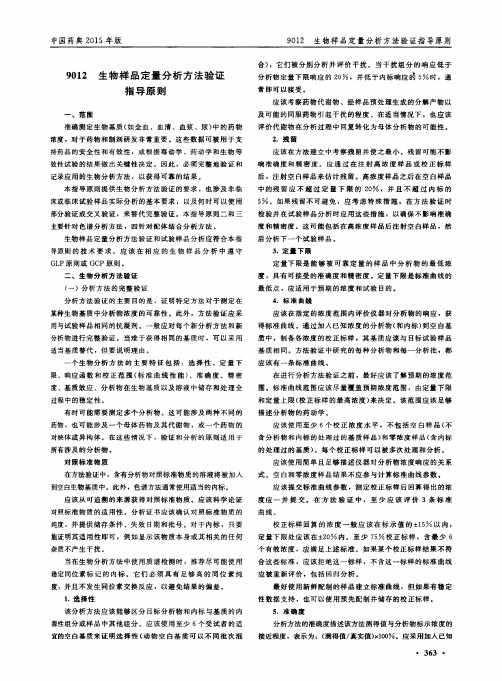
中国药典2015年版9012生物样品定置分析方法验证指导原则一、范围准确测定生物基质(如全血、血清、血浆、尿)中的药物浓度,对于药物和制剂研发非常重要。
这些数据可被用于支持药品的安全性和有效性,或根据毒动学、药动学和生物等效性试验的结果做出关键性决定。
因此,必须完整地验证和记录应用的生物分析方法,以获得可靠的结果。
本指导原则提供生物分析方法验证的要求,也涉及非临床或临床试验样品实际分析的基本要求,以及何时可以使用部分验证或交叉验证,来替代完整验证。
本指导原则二和三主要针对色谱分析方法,四针对配体结合分析方法。
生物样品定量分析方法验证和试验样品分析应符合本指导原则的技术要求。
应该在相应的生物样品分析中遵守G L P原则或GC P原则。
二、生物分析方法验证(一)分析方法的完整验证分析方法验证的主要目的是,证明特定方法对于测定在某种生物基质中分析物浓度的可靠性。
此外,方法验证应采用与试验样品相同的抗凝剂。
一般应对每个新分析方法和新分析物进行完整验证。
当难于获得相同的基质时,可以采用适当基质替代,但要说明理由。
一个生物分析方法的主要特征包括:选择性、定量下限、响应函数和校正范围(标准曲线性能)、准确度、精密度、基质效应、分析物在生物基质以及溶液中储存和处理全过程中的稳定性。
有时可能需要测定多个分析物。
这可能涉及两种不同的药物,也可能涉及一个母体药物及其代谢物,或一个药物的对映体或异构体。
在这些情况下,验证和分析的原则适用于所有涉及的分析物。
对照标准物质在方法验证中,含有分析物对照标准物质的溶液将被加人到空白生物基质中。
此外,色谱方法通常使用适当的内标。
应该从可追溯的来源获得对照标准物质。
应该科学论证对照标准物质的适用性。
分析证书应该确认对照标准物质的纯度,并提供储存条件、失效日期和批号。
对于内标,只要能证明其适用性即可,例如显示该物质本身或其相关的任何杂质不产生干扰。
当在生物分析方法中使用质谱检测时,推荐尽可能使用稳定同位素标记的内标。
9012生物样品定量分析方法验证指导原则
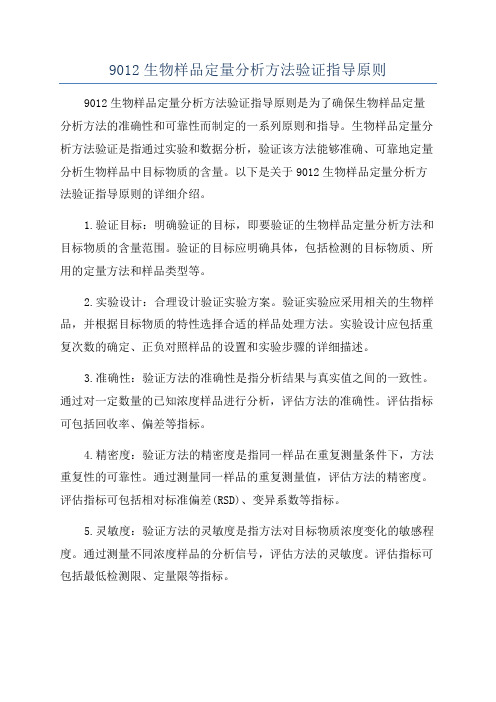
9012生物样品定量分析方法验证指导原则9012生物样品定量分析方法验证指导原则是为了确保生物样品定量分析方法的准确性和可靠性而制定的一系列原则和指导。
生物样品定量分析方法验证是指通过实验和数据分析,验证该方法能够准确、可靠地定量分析生物样品中目标物质的含量。
以下是关于9012生物样品定量分析方法验证指导原则的详细介绍。
1.验证目标:明确验证的目标,即要验证的生物样品定量分析方法和目标物质的含量范围。
验证的目标应明确具体,包括检测的目标物质、所用的定量方法和样品类型等。
2.实验设计:合理设计验证实验方案。
验证实验应采用相关的生物样品,并根据目标物质的特性选择合适的样品处理方法。
实验设计应包括重复次数的确定、正负对照样品的设置和实验步骤的详细描述。
3.准确性:验证方法的准确性是指分析结果与真实值之间的一致性。
通过对一定数量的已知浓度样品进行分析,评估方法的准确性。
评估指标可包括回收率、偏差等指标。
4.精密度:验证方法的精密度是指同一样品在重复测量条件下,方法重复性的可靠性。
通过测量同一样品的重复测量值,评估方法的精密度。
评估指标可包括相对标准偏差(RSD)、变异系数等指标。
5.灵敏度:验证方法的灵敏度是指方法对目标物质浓度变化的敏感程度。
通过测量不同浓度样品的分析信号,评估方法的灵敏度。
评估指标可包括最低检测限、定量限等指标。
6.选择性:验证方法的选择性是指方法对其他干扰物质的响应能力。
通过测量其他相关物质的干扰试验,评估方法的选择性。
评估指标可包括干扰物质的峰检出率、峰分离度等指标。
7.稳定性:验证方法的稳定性是指方法在规定条件下的变化范围。
通过存储试样的时效试验、方法的变更试验等,评估方法的稳定性。
评估指标可包括试样的峰面积或峰高百分含量的变化程度。
8.结果分析:根据验证实验的结果,进行数据统计和分析。
根据评估指标的要求,判断方法是否满足准确性、精密度、灵敏度、选择性和稳定性等要求。
结果分析应包括合理的统计方法和结果显示方式。
生物样品定量分析方法验证指导原则
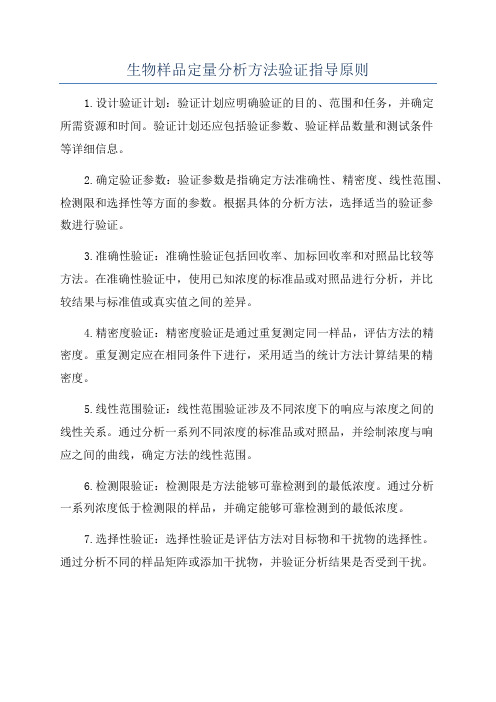
生物样品定量分析方法验证指导原则1.设计验证计划:验证计划应明确验证的目的、范围和任务,并确定所需资源和时间。
验证计划还应包括验证参数、验证样品数量和测试条件等详细信息。
2.确定验证参数:验证参数是指确定方法准确性、精密度、线性范围、检测限和选择性等方面的参数。
根据具体的分析方法,选择适当的验证参数进行验证。
3.准确性验证:准确性验证包括回收率、加标回收率和对照品比较等方法。
在准确性验证中,使用已知浓度的标准品或对照品进行分析,并比较结果与标准值或真实值之间的差异。
4.精密度验证:精密度验证是通过重复测定同一样品,评估方法的精密度。
重复测定应在相同条件下进行,采用适当的统计方法计算结果的精密度。
5.线性范围验证:线性范围验证涉及不同浓度下的响应与浓度之间的线性关系。
通过分析一系列不同浓度的标准品或对照品,并绘制浓度与响应之间的曲线,确定方法的线性范围。
6.检测限验证:检测限是方法能够可靠检测到的最低浓度。
通过分析一系列浓度低于检测限的样品,并确定能够可靠检测到的最低浓度。
7.选择性验证:选择性验证是评估方法对目标物和干扰物的选择性。
通过分析不同的样品矩阵或添加干扰物,并验证分析结果是否受到干扰。
8.数据分析:在验证完成后,应进行数据分析和评估。
使用适当的统计方法,计算准确度、精密度和线性范围等参数,并评估分析方法的可行性和可靠性。
9.结果报告和文件管理:验证的结果应记录并报告。
应编写验证报告,包括验证计划、实验结果、数据分析和结论等。
还应制定相应的文件管理措施,以确保验证结果的追溯性。
综上所述,生物样品定量分析方法验证是确保分析结果准确性和可靠性的重要步骤。
实施验证需要设计验证计划、确定验证参数、进行准确性、精密度、线性范围、检测限和选择性等方面的验证,并进行数据分析和结果报告。
通过遵循上述指导原则,可以有效验证生物样品定量分析方法的可行性和可靠性。
中国药典2024年版生物样品定量分析方法验证指导原则
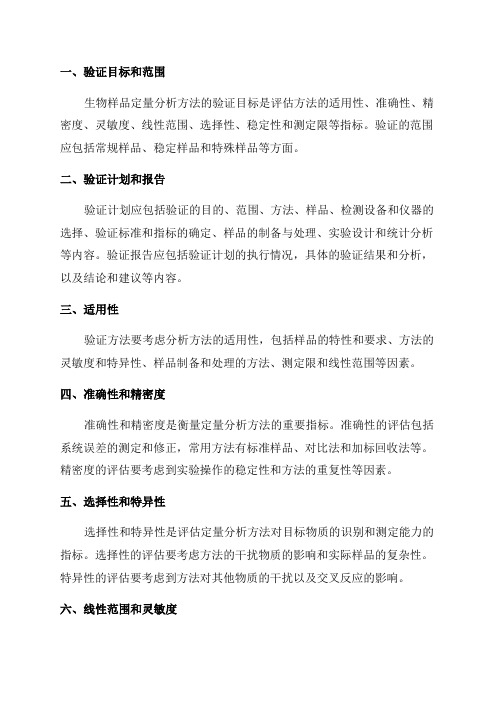
一、验证目标和范围生物样品定量分析方法的验证目标是评估方法的适用性、准确性、精密度、灵敏度、线性范围、选择性、稳定性和测定限等指标。
验证的范围应包括常规样品、稳定样品和特殊样品等方面。
二、验证计划和报告验证计划应包括验证的目的、范围、方法、样品、检测设备和仪器的选择、验证标准和指标的确定、样品的制备与处理、实验设计和统计分析等内容。
验证报告应包括验证计划的执行情况,具体的验证结果和分析,以及结论和建议等内容。
三、适用性验证方法要考虑分析方法的适用性,包括样品的特性和要求、方法的灵敏度和特异性、样品制备和处理的方法、测定限和线性范围等因素。
四、准确性和精密度准确性和精密度是衡量定量分析方法的重要指标。
准确性的评估包括系统误差的测定和修正,常用方法有标准样品、对比法和加标回收法等。
精密度的评估要考虑到实验操作的稳定性和方法的重复性等因素。
五、选择性和特异性选择性和特异性是评估定量分析方法对目标物质的识别和测定能力的指标。
选择性的评估要考虑方法的干扰物质的影响和实际样品的复杂性。
特异性的评估要考虑到方法对其他物质的干扰以及交叉反应的影响。
六、线性范围和灵敏度线性范围是评估定量分析方法测定结果与目标物质浓度之间的关系的指标。
灵敏度是评估定量分析方法对目标物质低浓度范围内变化的敏感性的指标。
线性范围的评估要包括线性相关系数、回归方程和相关系数的确定。
灵敏度的评估要考虑到检测限和测定限等因素。
七、稳定性稳定性是评估定量分析方法在时间、温度、湿度、光照等条件下的稳定性和耐受性的指标。
稳定性的评估要包括样品的稳定性、试剂的稳定性和仪器的稳定性等方面。
八、测定限测定限是评估定量分析方法可以测定的最低浓度的指标。
测定限的评估要考虑方法的灵敏度和噪声的干扰等因素。
综上所述,中国药典2024年版生物样品定量分析方法验证指导原则(草案)主要涵盖了验证目标和范围、验证计划和报告、适用性、准确性和精密度、选择性和特异性、线性范围和灵敏度、稳定性和测定限等方面的内容。
最新生物样本分析法指导原则
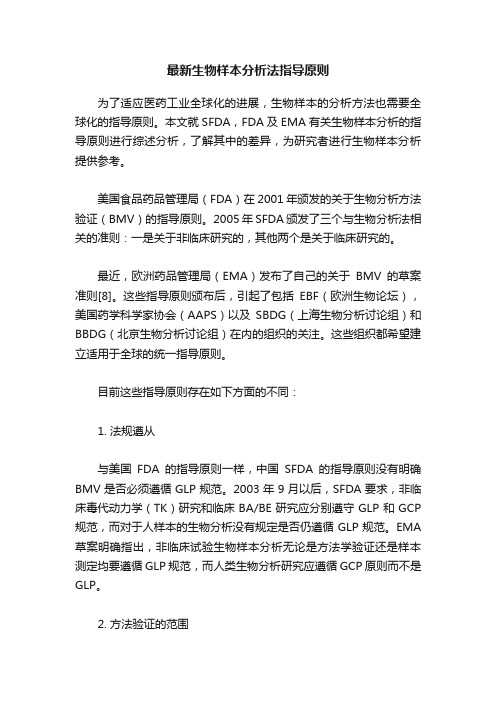
最新生物样本分析法指导原则为了适应医药工业全球化的进展,生物样本的分析方法也需要全球化的指导原则。
本文就SFDA,FDA及EMA有关生物样本分析的指导原则进行综述分析,了解其中的差异,为研究者进行生物样本分析提供参考。
美国食品药品管理局(FDA)在2001年颁发的关于生物分析方法验证(BMV)的指导原则。
2005年SFDA颁发了三个与生物分析法相关的准则:一是关于非临床研究的,其他两个是关于临床研究的。
最近,欧洲药品管理局(EMA)发布了自己的关于BMV的草案准则[8]。
这些指导原则颁布后,引起了包括EBF(欧洲生物论坛),美国药学科学家协会(AAPS)以及SBDG(上海生物分析讨论组)和BBDG(北京生物分析讨论组)在内的组织的关注。
这些组织都希望建立适用于全球的统一指导原则。
目前这些指导原则存在如下方面的不同:1. 法规遵从与美国FDA的指导原则一样,中国SFDA的指导原则没有明确BMV是否必须遵循GLP规范。
2003年9月以后,SFDA要求,非临床毒代动力学(TK)研究和临床BA/BE研究应分别遵守GLP和GCP 规范,而对于人样本的生物分析没有规定是否仍遵循GLP规范。
EMA 草案明确指出,非临床试验生物样本分析无论是方法学验证还是样本测定均要遵循GLP规范,而人类生物分析研究应遵循GCP原则而不是GLP。
2. 方法验证的范围分析方法学的全部方法学验证的范围,SFDA、FDA和EMA的要求基本一致。
对于在不同种属间进行TK研究的生物样本分析,SFDA 和FDA指导原则要求在更换种属时,仅要求部分方法学验证,而EMA 要求全部验证。
3. 对照和内标SFDA的指导原则要求在分析方法验证时应记录待测物、代谢产物及内标的信息(例如,纯度,来源和稳定性),但目前尚没有具体的质量标准要求。
FDA指导原则规定了待测药物对照品的质量要求,但没有强调作为内标使用的化学品的质量要求[4]。
EMA指导原则既规定了对照品的质量标准,又规定了内标的质量标准,还对内标的稳定性提出了要求[8]。
9012生物样品定量分析方法验证指导原则

9012生物样品定量分析方法验证指导原则生物样品定量分析方法验证是确保所采用的分析方法能够准确、可靠地定量生物样品中目标分析物的含量的过程。
验证验证是科学研究中非常重要的步骤,能够确保分析方法的可靠性和有效性。
本文将就生物样品定量分析方法验证的指导原则进行详细介绍。
一、准备工作:1.要明确分析方法的目的和要求,明确分析的目标物质、相关物质和可能影响分析结果的有害物质。
2.正确选择参考标准物质,确保其纯度、稳定性和可获得性。
二、验证方案的制定:1.根据样品的特点和目标物质的性质,制定验证方案。
验证方案应包括验证对象(样品类型、目标物质),验证方法(样品前处理、分析流程),验证指标(准确度、精密度、线性等)等内容。
2.确定验证方案的验证参数,包括样品容量、配制方案、浓度范围等。
三、验证准确度:1.准确度是指分析结果与真实值的接近程度。
验证准确度可以使用加标回收率和对照样品法进行验证。
2.加标回收率验证是在不同浓度水平下,加入一定量的目标物质,并对其进行分析,计算加标回收率。
3.对照样品法是用已知浓度的标准物质进行测定,计算其测定值与已知浓度之间的偏差。
四、验证精密度:1.精密度是指同一样品在同一实验室下,通过多次测定得到的结果的一致性。
验证精密度可以使用重复测定法进行验证。
2.重复测定法是在相同条件下,对同一样品进行多次独立测定,计算测定结果的方差或相对标准偏差。
五、验证线性范围:1.线性范围是指分析方法能够在一定范围内随着目标物质浓度的变化而呈现线性关系。
验证线性范围可以使用系列标准品浓度进行测定,绘制标准曲线。
2.根据标准曲线,分析样品中目标物质的浓度,在线性范围内,测定值与实际浓度之间的误差应在一定范围内。
六、其他验证指标:除了上述的准确度、精密度和线性范围,根据实际需要,还可以对选择性、稳定性、重复性、指标回收率等指标进行验证。
七、结果分析和报告:1.对验证结果进行评价和分析,判断分析方法是否满足要求。
2024药典生物样品定量分析方法验证指导原则

2024药典生物样品定量分析方法验证指导原则2024药典生物样品定量分析方法验证指导原则是指对于药物及其原料药以及相关的生物样品进行定量分析方法验证的准则和指导性原则。
这些原则是为了确保药物和生物样品的准确性、可靠性和重复性,从而保证药物的质量和安全性。
以下是关于2024药典生物样品定量分析方法验证指导原则的详细介绍。
首先,2024药典生物样品定量分析方法验证指导原则要求验证人员具有相应的专业知识和经验,能够进行准确、可靠和重复的测试。
验证人员应具备合适的教育背景、培训经历和实践经验,能够正确操作和解释测试结果。
其次,验证步骤应按照规定的程序和要求进行。
验证步骤包括方法准确性验证、方法精密度验证、方法线性范围验证、方法选择度验证和方法稳定性验证等。
这些步骤能够评估方法的准确性、精密度、线性范围、选择度和稳定性等重要指标。
方法准确性验证是评估方法测量结果与真实值之间差异的步骤。
验证人员可以通过比较方法测得的样品浓度与已知浓度的样品进行对照,以评估方法的准确性。
方法精密度验证是评估方法测量结果的一致性和重复性的步骤。
验证人员应根据规定的程序使用不同的检测设备、分析仪器和操作员对同一样品进行多次测试,以评估方法的精密度。
方法线性范围验证是评估方法在一定浓度范围内能否提供可靠测量结果的步骤。
验证人员应根据规定的程序和要求,测试一系列浓度不同的样品,以评估方法的线性范围。
方法选择度验证是评估方法在存在多种干扰物或类似物质的情况下是否准确测量目标物质的步骤。
验证人员可以通过加入干扰物或其他相关物质来评估方法的选择度。
方法稳定性验证是评估方法在不同条件下是否产生相似结果的步骤。
验证人员应根据规定的程序和要求,测试样品在不同条件下的稳定性,以评估方法的稳定性。
最后,验证人员应根据验证结果制定合适的验证报告,包括验证方案、方法验证结果、数据分析和结论等内容。
验证报告应清晰、准确地描述验证过程和结果,并提供可验证性的依据。
药典生物样品定量分析方法验证指导原则
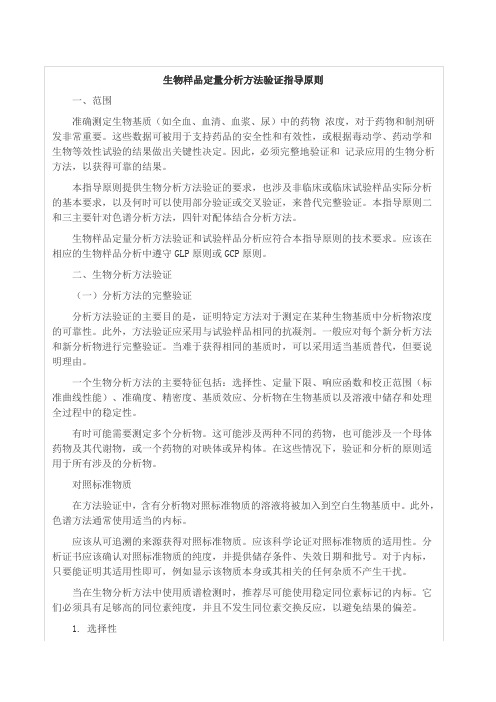
在对已被验证的分析方法进行小幅改变情况下,根据改变的实质内容,可能需要部分方法验证。可能的改变包括:生物分析方法转移到另一个实验室,改变仪器、校正浓度范围、样品体积,其他基质或物种,改变抗凝剂、样品处理步骤、储存条件等。应报告所有的改变,并对重新验证或部分验证的范围说明理由。
(三)交叉验证
3. 定量下限
定量下限是能够被可靠定量的样品中分析物的最低浓度,具有可接受的准确度和精密度。定量下限是标准曲线的最低点,应适用于预期的浓度和试验目的。
4. 标准曲线
应该在指定的浓度范围内评价仪器对分析物的响应,获得标准曲线。通过加入已知浓度的分析物(和内标)到空白基质中,制备各浓度的校正标样,其基质应该与目标试验样品基质相同。方法验证中研究的每种分析物和每一分析批,都应该有一条标准曲线。
生物样品定量分析方法验证指导原则
一、范围
准确测定生物基质(如全血、血清、血浆、尿)中的药物 浓度,对于药物和制剂研发非常重要。这些数据可被用于支持药品的安全性和有效性,或根据毒动学、药动学和生物等效性试验的结果做出关键性决定。因此,必须完整地验证和 记录应用的生物分析方法,以获得可靠的结果。
本指导原则提供生物分析方法验证的要求,也涉及非临床或临床试验样品实际分析的基本要求,以及何时可以使用部分验证或交叉验证,来替代完整验证。本指导原则二和三主要针对色谱分析方法,四针对配体结合分析方法。
批间准确度
通过至少3个分析批,且至少两天进行,每批用定量下 限以及低、中、高浓度质控样品,每个浓度至少5个测定值来评价。准确度均值一般应在质控样品标示值的±15%范围内,对于定量下限,应在标示值的±20%范围内。
报告的准确度和精密度的验证数据应该包括所有获得的测定结果,但是已经记录明显失误的情况除外。
- 1、下载文档前请自行甄别文档内容的完整性,平台不提供额外的编辑、内容补充、找答案等附加服务。
- 2、"仅部分预览"的文档,不可在线预览部分如存在完整性等问题,可反馈申请退款(可完整预览的文档不适用该条件!)。
- 3、如文档侵犯您的权益,请联系客服反馈,我们会尽快为您处理(人工客服工作时间:9:00-18:30)。
European Medicines Agency7 Westferry Circus, Canary Wharf, London, E14 4HB, UK1 2 3 London, 19 November 2009Doc. Ref: EMEA/CHMP/EWP/192217/2009COMMITTEE FOR MEDICINAL PRODUCTS FOR HUMAN USE4 (CHMP)5 6 DRAFTGUIDELINE ON VALIDATION OF BIOANALYTICAL METHODS78DRAFT AGREED BY THE EFFICACY WORKING PARTY September 2009 ADOPTION BY CHMP FOR RELEASE FOR CONSULTATION 19 November 2009END OF CONSULTATION (DEADLINE FOR COMMENTS)31 May 20109 Comments should be provided using this template to EWPSecretariat@emea.europa.eu10 KEYWORDSCHMP, EMEA, Guideline, validation, bioanalytical method, analysesGUIDELINE ON VALIDATION OF BIOANALYTICAL METHODS 11121314151617181920212223242526272829303132333435363738TABLE OF CONTENTS1.INTRODUCTION (BACKGROUND) (3)2.SCOPE (3)3.LEGAL BASIS (3)4.METHOD VALIDATION (4)4.1C OMPLETE VALIDATION OF AN ANALYTICAL METHOD (4)4.1.1Selectivity (4)4.1.2Carry-over (5)4.1.3Lower limit of quantitation (5)4.1.4Calibration curve (5)4.1.5Accuracy (6)4.1.6Precision (7)4.1.7Dilution integrity (7)4.1.8Matrix effect (7)4.1.9Stability (8)4.2P ARTIAL VALIDATION (9)4.3C ROSS VALIDATION (9)4.4L IGAND-BINDING ASSAYS (9)5.ANALYSIS OF STUDY SAMPLES (10)5.1A NALYTICAL RUN (11)5.2A CCEPTANCE CRITERIA OF AN ANALYTICAL RUN (11)5.3C ALIBRATION RANGE (12)5.4R EANALYSIS OF STUDY SAMPLES (12)5.5I NTEGRATION (13)6.INCURRED SAMPLES REANALYSIS (13)7.STUDY REPORT (13)DEFINITIONS (16)39404142434546474849505152535456575859606162646566676869707172737475767778 EXECUTIVE SUMMARYThis guideline defines key elements and provides recommendations for the validation of bioanalytical methods. The guideline focuses on the validation of the analytical methods used for pharmacokinetic sample analysis. In addition, guidance will be provided with regard to the actual analysis of study samples.1.INTRODUCTION (background)44Measurement of drug concentrations in biological matrices is an important aspect of medicinal product development for those products containing new active substances as well as for line extensions and generic products. Such data may be required to support new applications as well as variations to authorised drug products. The results of toxicokinetic, pharmacokinetic and bioequivalence studies are used to make critical decisions supporting the safety and efficacy of a medicinal drug substance or product. It is therefore paramount that the applied bioanalytical methods used are well characterised, fully validated and documented to a satisfactory standard in order to yield reliable results.Acceptance criteria wider than those defined in this guideline may need to be used in special situations, such as analysis of complex matrices (e.g. solid tissues), when usual acceptance criteria cannot be met. This should be justified and prospectively defined.2.SCOPE55This guideline provides requirements for the validation of bioanalytical methods.In addition, specific aspects of the bioanalytical method itself will be addressed, e.g. the actual analysis of samples from toxicokinetic studies and clinical trials.Furthermore, this guideline will describe when partial validation or cross validation may represent an appropriate alternative approach to the complete validation of an analytical method.Some special techniques such as radio-labelled analysis methods using 14C labelled drugs, are not covered here, but even in such cases efforts should be made to apply to the principles of this guideline.3.LEGAL BASIS63This guideline has to be read in conjunction with the introduction and general principles (4) and Part I and II of the Annex I to Directive 2001/83 as amended. It applies to Marketing Authorisation Applications for human medicinal products submitted in accordance with the Directive 2001/83/EC as amended, and Regulation (EC) No. 726/2004, in which the analysis of drug concentrations in a biological matrix is part of the application.The validation of bioanalytical methods and the analysis of study samples should be performed in accordance with the principles of Good Laboratory Practice (GLP). However, as human bioanalytical studies fall outside of the scope of GLP, as defined in Directive 2004/10/EC, the sites conducting the human studies are not required to be monitored as part of a national GLP compliance programme. In addition, for clinical trials in humans the principles of Good Clinical Practice (GCP) should be followed.Furthermore, reference is made to the following EMEA guidelines:•Note for guidance on good clinical practices (CPMP/ICH/135/95).•Note for guidance on validation of analytical procedures: text and methodology(CPMP/ICH/381/95).81828384858687888990919293949596979899100 101 102103 104 105 106 107 108 109 110 111 112 113 114 115 116 117 119 120 121 4.METHOD VALIDATION794.1Complete validation of an analytical method80A complete method validation should be performed for any analytical method whether new or basedupon literature.The main objective of method validation is to demonstrate the reliability of a particular method for the determination of an analyte concentration in a specific biological matrix, such as blood, plasma, urine, saliva or tissue. Moreover, validation should be performed using the same anticoagulant as for the study samples. A full validation should be performed for each species concerned.In some cases, it may be problematic for validation purposes to obtain an identical matrix compared to the matrix of the study samples. A suitable alternative matrix may be used, e.g. synthetically prepared cerebrospinal fluid, if justified.The main characteristics of a bioanalytical method that are essential to ensure the acceptability of the performance and the reliability of analytical results are: selectivity, lower limit of quantitation, the response function (calibration curve performance), accuracy, precision, matrix effects, stability of the analyte(s) and any internal standard in the biological matrix and the stock and working solutions under the entire period of storage and processing conditions.Usually one analyte or drug has to be determined, but on occasions it may be appropriate to measure more than one analyte. This may involve two different drugs, but can also involve a parent drug with its metabolites, or the enantiomers or isomers of a drug. In these cases the principles of validation and analysis apply to all analytes of interest.Reference standardsDuring method validation, a blank biological matrix will be spiked with the analyte of interest using solutions of reference standard. In addition, an internal standard (IS) is normally used in chromatographic methods.It is important that the quality of the reference standard and IS is ensured, as the quality (purity) may affect the outcome of the analysis, and therefore the outcome of the study data. Therefore the reference standards used for the analytical validation and analysis should be obtained from an authentic and traceable source. Suitable reference standards, include certified standards such as compendial standards (EPCRS, USP, WHO), commercial available standards, or fully characterised standards prepared in-house or by an external non-commercial organisation. Suitability of the reference standard should be scientifically justified. The use of certified standards is not needed for IS, as long as the suitability for use is demonstrated, e.g. lack of interference is shown for the substance itself or any impurities thereof.Whoever the supplier, a certificate of analysis is required to ensure quality, stability, storage conditions, expiration date, batch number and purity of the reference standards.When MS detection is used in the bioanalytical method, a stable isotope-labelled IS is recommended to be used whenever possible. However, it is essential that the labelled standard is of the highest isotope purity and that no isotope exchange reaction occurs. The presence of any unlabelled analyte would otherwise introduce a bias in the results.4.1.1Selectivity118The analytical method should be able to differentiate the analyte(s) of interest and IS from endogenous components in the matrix (i.e. blood, plasma, urine) or other components in the sample. Selectivity should be proven by using at least 6 sources of the appropriate blank matrix, which are individually122 123124 125 126 127128 129 130 131 132 133 134 135 136 137 138 139 141 142 143 144 145 146 147148 149 151 152 153155 156 157 158 159 160 161 162 163 164 165 166 analysed and evaluated for interference. Absence of interfering components is accepted where the response is less than 20% of the lower limit of quantitation for the analyte.It may also be necessary to investigate the extent of any interference caused by metabolites of the drug(s), interference from degradation products formed during sample preparation, and interference from possible co-administered medications. Co-medications normally used in the subject population studied should be taken into account.The possibility of back-conversion of a metabolite into parent analyte during the successive steps of the analysis (including extraction procedures) should also be evaluated, when relevant (e.g. acidic metabolites to ester, unstable N-oxides or glucuronide metabolites, lactone-ring structures). Preferably, blank matrix (and/or samples spiked with analyte at a concentration not higher than 3 times the lower limit of quantitation) should be spiked with concentrations of the metabolite of interest, representing the actual highest in vivo metabolite concentrations, the sample should be processed, and the chromatogram should be evaluated for the formation of the parent analyte. The extent of back-conversion should be established and the impact on the study results discussed. It is acknowledged that this evaluation will not be possible early during drug development of a new chemical entity when the metabolism is not yet evaluated. However, it is expected that this issue is taken into account and the analytical method is revalidated as further knowledge regarding metabolism of the active substance is gained during drug development.4.1.2Carry-over140Carry-over should be addressed and minimised during method development. Carry-over may not affect accuracy and precision (see section 4.1.5 and 4.1.6). During validation carry-over should be assessed by injecting blank samples after a high concentration sample or calibration standard. If it appears that carry-over is unavoidable, specific measures should be considered, tested during the validation and applied during the analysis of the study samples. This could include the injection of blank samples after samples with an expected high concentration, before the analysis of the next study sample.Randomisation of samples should be avoided, as this may interfere with the detection and assessment of carryover problems.4.1.3Lower limit of quantitation150The lower limit of quantitation (LLOQ) is the lowest amount of analyte in a sample which can be quantified reliably, with an acceptable accuracy and precision (see Accuracy and Precision). The LLOQ should be adapted to expected concentrations and to the aim of the study.4.1.4Calibration curve154The response of the instrument with regard to the analyte should be known, and should be evaluated over a specified concentration range. The concentrations to be analysed (calibration standards) should be prepared in the same matrix as the matrix of the intended study samples by spiking the blank matrix with known concentrations of the analyte (and IS). There should be one calibration curve for each analyte studied in the method validation and for each analytical run.Before carrying out the validation of the analytical method it should be known what concentration range is expected. This range should be covered by the calibration curve range, defined by the LLOQ being the lowest calibration standard and the upper limit of quantitation (ULOQ), being the highest calibration standard. The range should be justified based on scientific information.A minimum of six calibration concentration levels should be used, excluding the blank sample(processed matrix sample without analyte and without IS) and a zero sample (processed matrix with IS).167 168 169170 171 172 173174 175 176 177 178179 180 181 183 184 185 186 187 188 189 190191 192 193 194 195 196 197 198 199200 201 202 203 204205 206 207 208 A relationship which can simply and adequately describe the response of the instrument with regard to the analyte should be applied. The blank and zero samples should not be taken into consideration to calculate the calibration curve parameters.The calibration curve parameters should be submitted (slope and intercept in case of linear fit). In addition, the back calculated concentrations of the calibration standards should be presented together with the calculated mean accuracy values (see definition of Accuracy below). At least 3 calibration curves should be evaluated.The back calculated concentrations of the calibration standards should be within ±15% of the nominal value, except for the LLOQ for which it should be within ±20%. At least 75% of the calibration standards with a minimum of six, must fulfil this criterion. In case a calibration standard does not comply with these criteria, this calibration standard sample should be rejected, and the calibration curve without this calibration standard should be re-evaluated, including regression analysis. Although it may be clear from stability data that the analyte is sufficiently stable in the matrix of interest, it is recommended that freshly prepared calibration curves are used during validation of the bioanalytical method.4.1.5Accuracy182The accuracy of an analytical method describes the closeness of the determined value obtained by the method to the true concentration of the analyte (expressed in percentage). Accuracy should be assessed on samples spiked with known amounts of the analyte, the quality control samples (QC samples).During method validation accuracy should be determined by replicate analysis using a minimum of5 determinations at a minimum of 4 concentration levels which are covering the calibration curverange: the LLOQ, within three times the LLOQ (low QC), around 50% of the calibration curve range (medium QC), and at about 75% of the upper calibration curve range (high QC).The QC samples are analysed against the calibration curve, and the obtained concentrations are compared with the nominal value. The accuracy should be reported as percent of the nominal value.Accuracy should be evaluated for the values of the QC samples obtained within a single run (the within run accuracy) and in different runs (the between-run accuracy). The latter will support the accuracy over time.To enable evaluation of any trends over time within one run, it is recommended to demonstrate accuracy of QC samples over at least one of the runs with a size equivalent to a prospective analytical run.Within-run accuracyFor the validation of the within-run accuracy, there should be a minimum of five samples per concentration level at LLOQ, low, medium and high QC samples in a single run. The mean accuracy value should be within 15% of the nominal values for the QC samples, except for the LLOQ which should be within 20% of the nominal value.Between –run accuracyFor the validation of the between-run accuracy at least five determinations per concentration per run at LLOQ, low, medium and high QC samples from three runs analysed on at least two different days should be evaluated. The mean accuracy value should be within 15% of the nominal values for the QC samples, except for the LLOQ which should be within 20% of the nominal value.209 210 211213 214 215 216 217 218 219 220 221 222 223225 226 227 228 229 231 232 233 234 235 236 237 238239 240 241 242 243 244 245 246 247 248 249 Reported method validation data and the determination of accuracy and precision should include all outliers; however, calculations of accuracy and precision excluding values that are statistically determined as outliers should additionally be reported.4.1.6Precision212The precision of the analytical method describes the closeness of repeated individual measures of analyte. Precision is expressed as the coefficient of variation (CV). The statistical method for estimation of the precision should be predefined and calculated according standard practise. Precision should be demonstrated for the LLOQ, low, medium and high QC samples, within a single run and between different runs, i.e. using the results generated for demonstration of accuracy.Within-run precisionThe within-run CV value should not exceed 15% for the QC samples, except for the LLOQ which should not exceed 20%.Between –run precisionThe between-run CV value should not exceed 15% for the QC samples, except for the LLOQ which should not exceed 20%.4.1.7Dilution integrity224Dilution of samples should not interfere with the accuracy and precision. Dilution integrity should be demonstrated by spiking the matrix with an analyte concentration above the ULOQ and dilution of this sample with blank matrix (at least five determinations per dilution factor). Accuracy and precision should be within the set criteria, i.e. within ±15%. Dilution integrity should cover the applied dilution of the study samples.4.1.8Matrix effect230Matrix effects should be investigated when using mass spectrometric methods, using at least 6 lots of matrix including haemolysed, hyperlipidaemic and if applicable, sample matrix from special populations, such as renally or hepatically impaired populations.For each analyte and the internal standard, the matrix factor (MF) should be calculated in each lot of matrix, by calculating the ratio of the peak area in the presence of matrix (measured by analysing blank matrix spiked with analyte at a concentration of maximum 3 times the LLOQ after extraction), to the peak area in absence of matrix (pure solution of the analyte). The IS normalised MF should also be calculated by dividing the MF of the analyte by the MF of the IS.The CV of the IS-normalised MF calculated from the 6 batches of matrix should not be greater than15 %.If this approach cannot be used, for instance in the case of on-line sample preparation, the variability of the response from batch to batch should be assessed by analysing at least 6 batches of matrix in triplicate, spiked at a concentration of a maximum of 3 times the LLOQ. The validation report should include the peak areas of the analyte and of the IS and the calculated concentration for each individual sample. The overall CV calculated for the concentration should not be greater than 15 %. The mean concentration should be within 15 % of the nominal concentration. The mean concentration should also be reported for each individual batch of matrix; a deviation of this mean from the nominal concentration of more than 20 % in any individual batch of matrix should lead to additional investigations.250 251252 253 254 255 256 258 259 260 261262 263 264 265 266 267 268 269 270 271272 273 274 275 276 277 278 279 280 281 282 283 284 285 286 287 288 If the matrix is difficult to obtain, less than 6 different batches of matrix may be used, but this should be justified. However, matrix effects should still be investigated.If a formulation for injection to be administered to the subjects or animals contains excipients known to be responsible for matrix effects, for instance polyethylene glycol or polysorbate, matrix effects should be studied with matrix containing these excipients, in addition to blank matrix. The matrix used for this evaluation should be obtained from subjects or animals administered the excipient, unless it has been demonstrated that the excipient is not metabolised or transformed in-vivo.4.1.9Stability257Evaluation of the stability should be carried out to ensure that every step taken during sample preparation and sample analysis, as well as the storage conditions used do not affect the concentration of the analyte. Any deviation from the initial concentration that does occur must be within acceptable limits.Stability should be ensured for every step in the analytical method, meaning that the conditions applied to the stability tests, such as sample matrix, materials storage and analytical conditions should be similar to those used for the actual study samples. Stability cannot be proven by literature data.Stability of the analyte and IS in the studied matrix is evaluated using at least triplicates samples of the low and high QC samples which are analysed immediately after preparation and after the applied storage conditions that are to be evaluated. The QC samples are analysed against a calibration curve, obtained from freshly prepared calibration standards, and the obtained concentrations are compared to the nominal concentrations. The deviation should be within ±15%.Stability of the stock and working solutions should be tested with an appropriate dilution, taking into consideration the linearity and measuring range of the detector.Stability studies should investigate different storage conditions over time periods that equal or exceed those applied to the actual study samples.Normally, as an example, the following stability tests should be evaluated:•stock solution and working solution stability,•freeze and thaw stability of the analyte in the matrix from freezer storage conditions to room temperature,•stability of the analyte in matrix stored in the refrigerator, if applicable,•bench top stability of the analyte in matrix at room temperature,•long term stability of the analyte in matrix stored in the freezer at the same storage temperature as the study samples,•bench top stability of the processed sample at room temperature or under the storage conditions to be used during the study (dry extract or in the injection phase), if applicable, •on-instrument/ autosampler stability of the processed sample at injector or autosampler temperature.Regarding the freeze and thaw stability: The QC samples are stored and frozen in the freezer at the intended temperature and thereafter thawed at room temperature. After thawing, samples are refrozen again applying the same conditions. At each cycle, samples should be frozen for at least 12 hours289 290 291 292 293 294 295 296 297 298 299301 302 303 304 305 306 307 309 310 311 312 313 314 315 316318 319 320 321 322 323324 325 326 327 328 329 330 before they are thawed. The number of cycles in the freeze-thaw stability should equal or exceed that of the freeze/thaw cycles of study samples.Regarding long term stability of the analyte in matrix stored in the freezer: The QC samples should be stored in the freezer under the same storage conditions and at least for the same duration as the study samples. For the evaluation of the long term stability it is not acceptable to use study samples, as the nominal concentration is unknown, and can therefore not be used as reference. It is recommended that evaluation of long term stability is carried out before the start of the actual study.Sufficient attention should be paid to the stability of the analyte in the sampled matrix directly after blood sampling of subjects and further preparation before storage, to ensure that the obtained concentrations by the analytical method reflect the concentrations of the analyte in the subject at the moment of sampling..4.2Partial validation300In situation where minor changes are made to an analytical method that has already been validated, a full validation may not be necessary, depending onto the nature of the applied changes. Changes for which a partial validation may be needed include transfer of the bioanalytical method to another laboratory, change in equipment, calibration concentration range, storage conditions etc. All modifications should be reported and the scope of revalidation or partial validation justified.In most cases, provision of additional accuracy and precision data or relevant additional stability data on the modified issue may be sufficient.4.3Cross validation308Where data are obtained from different study sites, comparison of those data is needed, and a cross validation of the applied analytical methods should be carried out. Differences in sample preparation or the use of another analytical method may result in different outcomes between the study sites. Cross validation should be performed in advance of study samples being analysed if possible. For the cross validation, the same set of QC samples should be analysed by both analytical methods. The outcome of the cross validation is critical in determining whether the obtained data are reliable and whether they can be compared and used. The difference between the two measurements should not exceed 15%.4.4Ligand-binding assays317Ligand-binding assays or immunoassays are nowadays especially used for macromolecules. In these assays, quantification is based on macromolecular interactions between the macromolecule and antibody.The validation principles and the issues with regard to analysis of study samples as indicated before, should also be applied in general for ligand-binding assays. However, the following issues need special attention.One of the issues is the fact that macromolecules tend to be heterogeneous (small differences in for instance glycosylation, or phosphorylation). Therefore validation must cover issues such as batch-to-batch differences in glycosylation and metabolic differences in phosphorylation.In addition, macromolecules may be structurally comparable to endogeneous compounds. Therefore, specificity of the antibody and selectivity of the assay are critical parameters for ligand-binding assays.Specificity of an antibody refers to its ability to mainly bind the antigen of interest. Ideally the antibody should be specific such that no cross-reactivity with structural related compounds occurs.331 332 333 334 335 336 337 338 339 340341 342 343 344345 346 347 348 349350 351 352 353 354355 356357 358 359 360 361362 363 364365366 367 368 369 371 372 373 374 Specificity is validated by using at least 10 sources of sample matrix, spiked at or near the LLOQ. The presence of endogenous antibodies to the analyte may interfere with the analysis and should be taken into account. As interference may be concentration dependent, it would be helpful to estimate the concentration below which interference occurs. Due to interference of endogenous compounds, the blank response may exceed 20% of the LLOQ, however this may be acceptable, as long as it does not affect accuracy. If a surrogate matrix is used for validation, the comparability with regard to study sample matrix should be demonstrated, because of the disease state of a subject, the study matrix may contain different components that may interfere. It is important that the sample matrix and the standard matrix are equivalent. If not, it must be shown that the dose-response relation (e.g. the slope and asymptotes of a four-parameter curve) is unaffected by the matrix.Reference standards should be selected in such a manner that specificity is ensured, and binding characteristics are durable and stable regarding antibody/antigen complex formation. A change in reference standard during analysis may affect this, and suitability of the new reference standard should thus be demonstrated.With regard to the calibration curve, the response is measured indirectly and as a result the response function is in most cases nonlinear. Moreover, generally the calibration curve range is limited (<2 orders of magnitude). In case anchor calibration standards are used, the additive value should be clearly documented. Accuracy of the back calculated concentrations should be within ±20%, except for LLOQ and ULOQ which should not exceed 25%.At least three QC samples should be included (low, medium and high) in each analytical run. The within-run and the between-run accuracy and precision should be within ±20%. Furthermore, the total error (sum of the absolute value of mean accuracy and precision should be less than 30% (40% at the LLOQ and ULOQ). The results of all runs should be included for validation, except in cases where errors are obvious and documented.It is recommended that the size of the run during validation is comparable to that of a run during analysis of study samples (or visa versa).It should be demonstrated that characteristics of the analyte are not affected by the methods of sample preparation, additives (e.g. anticoagulants), and stability during the whole process. Evaluation should not only address chemical and physical properties, but also biological integrity (i.e. maintenance of antibody binding affinity). In addition, this also accounts for changes after validation, e.g. a change in used diluents or reagents during analysis of study samples.If for analysis of study samples microtiter plate-based assays are used, a batch may comprise several individual plates, but each plate should contain an individual set of calibration standards and QC samples, to compensate for difference in plate performance.Commercial kitsCommercial kits may have been developed for other use or purposes than the intended use, e.g. analysis of samples obtained in bioequivalence studies. Therefore, commercial kits need to be re-validated, meaning that the LOQ and the QC samples in the actual concentration range perform accurately and precisely. The principles of validation listed before apply.5.ANALYSIS OF STUDY SAMPLES370After complete validation of the analytical method, analysis of study or subject samples may be carried out. Depending on the time period between validation and the analysis of the study samples it may be necessary to verify the performance of the method before start of the analysis of study samples.。
